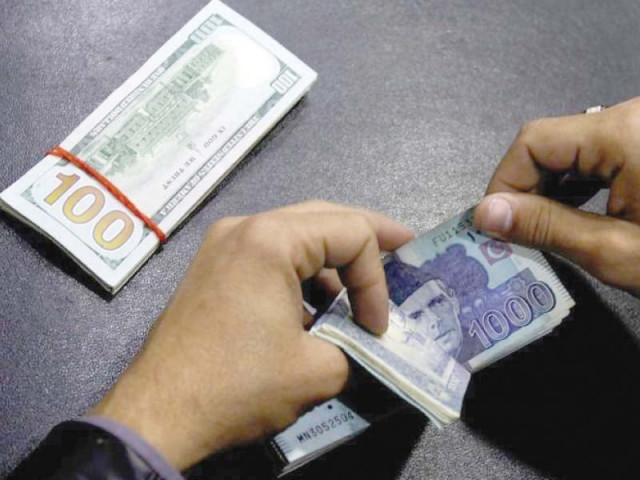Rupee’s fall set to change economic landscape
Imports will become expensive, inflation will rise, pressure on forex reserves will ease

An expected surge in inflation may convince the SBP to revise interest rate upwards by March 2018 against earlier forecast for June 2018. PHOTO: REUTERS
The depreciation is still lower than what was desired by exporters, foreign portfolio investors and global lending institutions such as the International Monetary Fund (IMF).
However, Prime Minister Shahid Khaqan Abbasi has categorically said that the government has no plans to let the rupee weaken further.
Experts now say the drop in rupee’s value will make imports expensive, push inflation to the annual target of 6% sometime in the middle of current fiscal year and force the central bank to increase interest rate by March 2018.
On the other hand, it will help the government reduce pressure on the external trade front, rein in the fast widening current account deficit, minimise pressure on foreign exchange reserves, attract higher remittances from Pakistanis abroad and delay the floating of more Eurobonds or going back to the IMF.
Institute of Bankers Pakistan Chief Executive Husain Lawai finds the rupee’s depreciation a healthy sign for the economy. “It will help reduce imports…revive exports and check the widening current account deficit.”
The current account deficit widened 122% in the first four months (July-October) of the current fiscal year 2017-18 to $5.01 billion compared to $2.26 billion in the same period of previous year, according to the State Bank of Pakistan (SBP).
“The move (depreciation)...will also help increase remittances as those who had chosen to send money back home via illegal hundi/hawala system should now rely on proper banking channels to enjoy a higher exchange rate,” Lawai said.
Rupee suffers 4% fall in intra-day movement
EFG Hermes Pakistan Chief Executive Officer Muzammil Aslam said, “Each percentage-point depreciation in the rupee adds up 0.5-0.75 percentage point to the inflation (in Pakistan).”
This suggests that inflation would touch the full-year target of 6% by January 2018 from an average of 3.59% in the first five months of FY18, he said. The expected surge in inflation may persuade the central bank to revise the interest rate upwards by March 2018 against earlier forecast for June 2018, he said.
The SBP has kept the policy rate unchanged at 5.75% since May 2016.
Another seasoned banker said the depreciation would not help the government a lot in placing a cap on the current account deficit due to structural problems on the external economic front like lack of export diversification and unnecessary imports.
“Pakistan will go back to the IMF by August-September 2018 despite floating Eurobonds and Sukuk (Islamic bond) worth $2.5 billion recently and increase in regulatory duty on imports,” he said.
Impact on PSX
The depreciation should leave a positive impact on the weakening Pakistan Stock Exchange (PSX) as earnings of heavyweight oil companies were closely linked with the dollar valuation in Pakistan, Aslam said.
It may also help revive textile exports and attract renewed interest in shares of listed companies.
The depreciation would be neutral-to-positive for banks as their earnings remain in domestic currency. However, the anticipated hike in the interest rate will make them attractive in the future.
The decision may prove negative for sectors like car and cement manufacturers as prices of imported commodities have started going up, he said.
Foreign portfolio investors
Foreign portfolio investors have remained net sellers at the PSX for around two and a half years now for one reason or the other.
The latest reason was imminent depreciation of the rupee which eventually happened in the past one week.
Pakistan’s external debt, liabilities increase 12.3% to $85b
Despite the depreciation, the foreign investors did not seem fully convinced to re-enter the stock market. They have welcomed the depreciation, but consider it insufficient.
“They (foreigners) expect the rupee to fall by 10-15%,” EFG Hermes CEO added.
Considering the benchmark KSE-100 Index’s offer of over 26% discount from the May 2017 peak of around 53,000 points, the foreign investors should have staged a comeback, which they did not.
“Political stability is a must to attract them in addition to the recent rupee depreciation and the market discount,” he said.
Foreigners have sold stocks worth $8.9 million at the PSX in the outgoing week while the benchmark index lost another 1.1% during the week to 38,645.90 points.
A banker added that the rupee may remain stable in the short-to-medium run and would start falling by 0.5-1% per month to Rs115 by June 2018.
Published in The Express Tribune, December 17th, 2017.
Like Business on Facebook, follow @TribuneBiz on Twitter to stay informed and join in the conversation.



















COMMENTS
Comments are moderated and generally will be posted if they are on-topic and not abusive.
For more information, please see our Comments FAQ